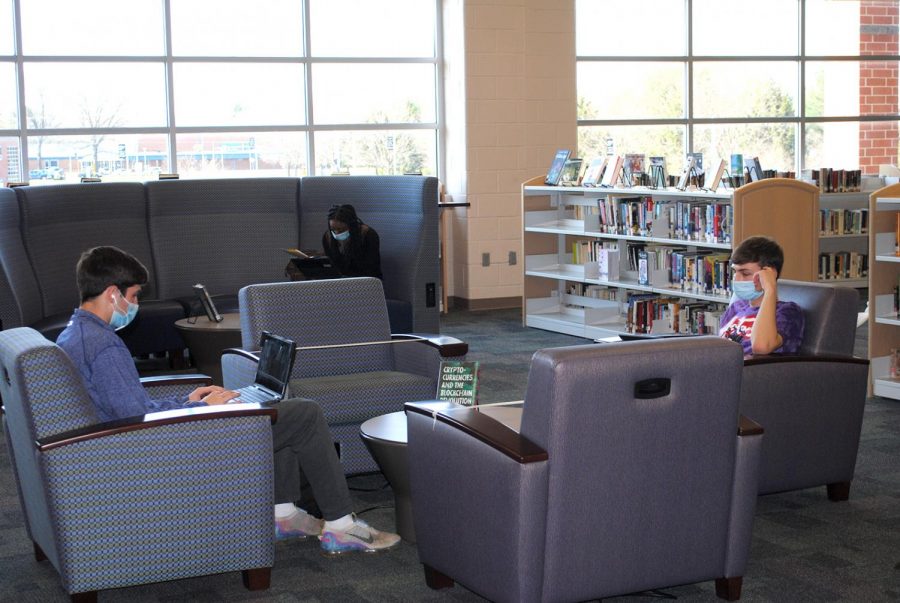COVID-19 One Year Later: A New Normal in Buildings
Spring-Ford’s halls, classrooms, rules look different amid pandemic
Spring-Ford students (from left) Joe Brogan, Destiny Barnes, and Anthony Sharpe study in the media center while socially distanced.
May 21, 2021
For students across the world, this past year has presented unpredictable learning conditions and obstacles due to the impact of the Coronavirus pandemic, as the education system quickly needed to reshape itself and adopt new methods in order to teach students safely and effectively.
It was just over a year ago that Spring-Ford students were informed they would miss two weeks from school due to the virus outbreak quickly spreading through Montgomery County.
That was March 12, of 2020.
The societal environment prior to the two-week break appears foreign to us now as the necessary changes brought by the pandemic heavily impacted students ever since.
¨School is definitely more difficult now than it was last year,” junior Jordan Littlejohn said. “All of the changes were very overwhelming.”
Part of that change is visible across the school and the community, as a prominent accessory in society, face masks, have become critical in order to safely navigate through the worldwide pandemic. Masks were a requirement with the introduction of in-person learning model. As a result, students needed to grow accustomed to learning throughout a seven-hour school day while wearing a mask.
“Even though many students complain about masks, they honestly are not bad at all,” sophomore Jake Blackmore said. “Overall I feel that wearing a mask is necessary, so I forget that I am even wearing one. Over the past few months, it has been easier to overcome the initial struggle with them.¨
Another major change over a year removed from that fateful March day is the number of students learning within the buildings.
It wasn’t that long ago when students in the 10-12 grade center felt that it was difficult to navigate through the hallways due to the large number of students within the building. This school year, however, students learning in-person have found that maneuvering in the building more tolerable as a considerable amount of students remain virtual.
For much of the school year, after an all-virtual start, students have been offered the opportunity to choose whether they prefer to learn in-person or virtually. According to school commitment survey data on the district’s website, roughly 1661 of the 2581 students in grades 9-12 chose to return to in-person instruction.
“It is definitely easier to maneuver the building with fewer students, and the school environment is very different,” said junior Garrett Wible. “There is a smaller amount of students in the classroom, which makes it less interactive.”
Despite a smaller number of in-person students, several building alterations needed to be instilled in order to accommodate safety measures. For instance, the 10-12 Center cafeteria no longer consists of long and circular tables that seat numerous students at a time. Currently, the cafeteria predominantly withholds individual desks that are distanced safely. In addition, there are a few long tables to sit only a small number of students at a time.
“The cafeteria is more spaced out now than before, and it mainly looks different because of the tables,” junior Matt Pytel stated. “Also, the social interaction is not too bad because you can still sit close enough to friends to talk.”
Social distancing stickers on hallway floors have also been added to the new layout in an effort to maintain the safety of students and staff. Additionally, desks within classrooms have undergone an increased distance from one another, which provides more safety among students. Student seating charts are also carefully maintained for accurate contact-tracing data. Hand sanitizing stations are also present in each classroom and several hallways.
Prior to this past school year, the environment during school looked significantly different. Students were more interactive, and factors such as social distancing, masks, and virtual learning were non-existent.
Though substantial changes made due to COVID-19 presented challenges to a students’ school day, students have exhibited great resiliency during the school year. As we approach the end of the school year, students and staff hope to return to a more normal environment next year.
“I am optimistic that next school year will look more traditional than our experience this year,¨ said Dr. Robert Colyer, 10-12 Center Principal. ¨I believe we are moving in the right direction, we are having more people getting vaccinated, venues are opening up and given that trajectory we will hopefully regain some of our more traditional, standard procedures.”
Standard procedures would be a welcome sight for students who have longed for a degree of normalcy during this unprecedented time.
“I really look forward to interacting with people next school year on a regular basis, like before,” junior John Mullin said.

